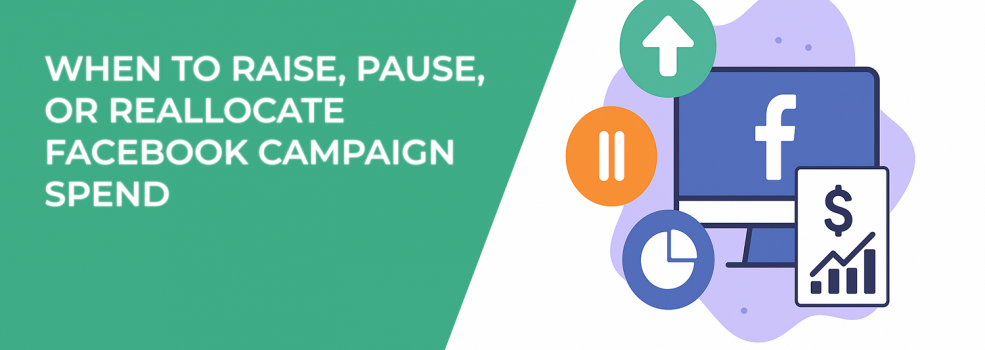Facebook advertising is rarely a set-it-and-forget-it process. Campaigns don’t all perform the same way — some keep generating sales at a healthy cost, others decline after an early burst, and many hover somewhere in between. The real challenge for advertisers is knowing how to manage budget in these different situations.
Should you add more money to a winning campaign? Stop a weak one altogether? Or move budget from one ad set to another? Those decisions determine whether you make the most of your ad spend or watch it drain away.
Let’s walk through the three key budget moves — raising, pausing, and reallocating — and look at how to spot the right moment for each.
When to Raise Your Budget
Increasing your budget can be one of the most powerful moves you make — but only when the numbers prove the campaign is strong enough to handle more. Pouring extra money into the wrong ad set almost always leads to wasted spend.
Before scaling, look for a few green lights:
-
Results are steady. A campaign should show consistent performance over several days. One “good day” isn’t enough evidence.
-
ROAS is above your goal. If every $10 spent reliably brings in $30 or more, that’s a clear signal.
-
Your audience pool is still broad. Bigger audiences give you space to expand without hitting fatigue too quickly.
If you’re planning to scale, you’ll also want to understand how budget allocation impacts the learning phase. Ads that get too much money too fast often reset delivery. For a deep dive on this, check out The Science of Scaling Facebook Ads Without Killing Performance.
When you do decide to raise, take it slow:
-
Raise budgets gradually, usually by 20–30% at a time.
-
Use campaign budget optimization to let Facebook direct spend toward the strongest ad sets.
-
Experiment with horizontal scaling — duplicating winning ad sets and testing new creatives or audiences instead of just pumping money into one.
Example: An online fitness coach runs a campaign for a new course. One ad set is generating leads at $8 each against a goal of $15. Instead of jumping the budget from $100/day to $500, she increases by 25%, then duplicates the ad set with new creative to broaden reach. Both keep delivering affordable leads, and she scales steadily without breaking performance.
When to Pause a Campaign
No matter how much effort you put into creative or targeting, some campaigns run their course. The worst thing you can do is keep paying for clicks or conversions that no longer make sense. Pausing isn’t failure — it’s efficiency.
There are clear warning signs:
-
Costs keep climbing. If your CPA rises week after week with no clear cause, the ad is likely past its peak.
-
Click-through rate falls sharply. People are scrolling past instead of engaging.
-
Frequency gets too high. If your audience has seen the same ad five or six times, fatigue sets in.
-
Audience feedback is negative. Hides, spam flags, or negative comments hurt both delivery and brand perception.
This problem often comes down to ad fatigue. Recognizing the signs early — and rotating creative before fatigue kills performance — can save you thousands.
When you pause, do it with intention. Don’t just flip the switch and forget:
-
Give the campaign enough spend before deciding (usually 3–5 times your target CPA).
-
Save reports and learnings before shutting it down.
-
Consider pausing only cold traffic while keeping retargeting campaigns live.
Example: A SaaS company advertises a free trial. At first, sign-ups cost $15. Two weeks later, they’re at $50, and CTR has dropped. The brand pauses the campaign, takes notes on what worked, and relaunches with a new creative angle featuring customer case studies. The fresh ads restore performance and keep leads affordable.
When to Reallocate Budget
Reallocation is often overlooked, but it’s one of the smartest ways to stretch your ad dollars. Instead of adding more budget or shutting things down, you simply move spend from underperforming areas to stronger ones.
Here are the moments to consider it:
-
One ad set is clearly outperforming the others. If one is converting at half the cost, it deserves more fuel.
-
Tests reveal a winner. When A/B tests show one creative bringing far better engagement, reallocate spend quickly.
-
Funnel stages are imbalanced. If your top-of-funnel traffic is healthy but mid-funnel retargeting lags, shift more toward the stage that drives conversions.
If you’re not sure where your money should move, you may need to step back and evaluate the whole funnel. This guide on Facebook Ads Funnel Strategy can help map which stage deserves the bigger slice of your budget.
How to do it effectively:
-
Pull budget from the weakest ad sets and push it into proven performers.
-
Shift money between objectives — from traffic to conversions, for example — if your goals aren’t being met.
-
Adjust based on timing. Seasonal promotions or trending products deserve more spend while interest is hot.
Example: A fashion retailer runs three ad sets: retargeting website visitors at $12 per sale, lookalikes at $28, and broad interests at $70. Instead of throwing more money overall, they cut spend from the interest group and reallocate it to retargeting. Their average CPA drops instantly without raising total budget.
Everyday Budgeting Habits
Daily decisions matter as much as big shifts. Advertisers who succeed long term build habits around checking numbers and adjusting with care.
Some simple habits that work:
-
Automated rules. Set rules to automatically pause ads if CPA gets too high or increase spend slightly if ROAS holds strong. Here’s a walkthrough on how to use automated rules effectively.
-
Look at 7-day trends. Avoid reacting to a single bad (or good) day.
-
Plan for seasonality. Some cost increases are normal during busy periods, and not every spike means you should pause.
-
Track long-term value. A campaign that looks pricey up front may still be worth it if customers come back for repeat purchases.
These habits might sound simple, but they add discipline to campaign management. They keep you from making knee-jerk changes that hurt performance and ensure your decisions are based on meaningful patterns rather than short-term swings. The more consistent you are in applying them, the easier it becomes to spot what’s working, what’s stalling, and where your money will have the biggest impact.
Final Thoughts
Managing Facebook ad spend well isn’t about rigid formulas. It’s about looking at your data, asking the right questions, and adjusting budgets where they’ll do the most good.
-
Raise when you see sustainable performance and room to scale.
-
Pause when the numbers show your ad has run out of steam.
-
Reallocate when some campaigns clearly deserve more than others.
If you want to go deeper into strategy, our guide on Best Practices for Facebook Ads Spending offers more ways to balance efficiency with growth.
With this approach, you don’t just spend more or less — you spend smarter.

